REMINGTON 770 User Manual [fr]
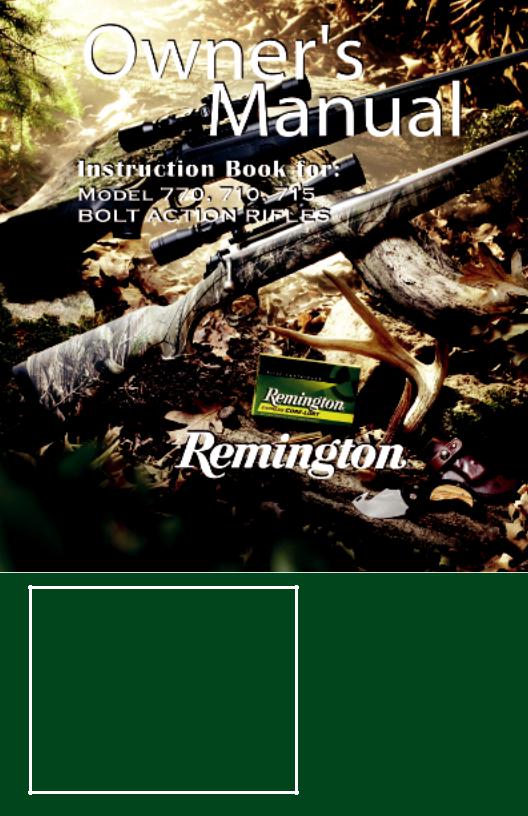
IMPOR TANT!
This manual contains operating, care, and maintenance instructions. To assure safe operation, any user of this firearm must
read and understand this manual before using the firearm. Failure to follow the instructions and heed the warnings in this manual can cause property damage, personal injury, and/or death.
This manual should always accompany this firearm, and be transferred with it upon change of ownership. WARNING! Keep this firearm out of the reach of children, unauthorized individuals, and others unfamiliar with safe handing of firearms.
Page 2 .......... |
The Ten Commandments of |
|
Firearm Safety |
Page 7 .......... |
Important Parts of the |
|
Firearm |
Page 11 .......... |
To Load the Firearm |
Page 13 .......... |
How To Unload the Firearm |
Page 14 .......... |
Lubrication and Maintenance |
Page 19 .......... |
To Function Test the |
|
Firearm |
Page 23 .......... |
Parts List |
Page 24 .......... |
How to Obtain Parts and |
|
Service |
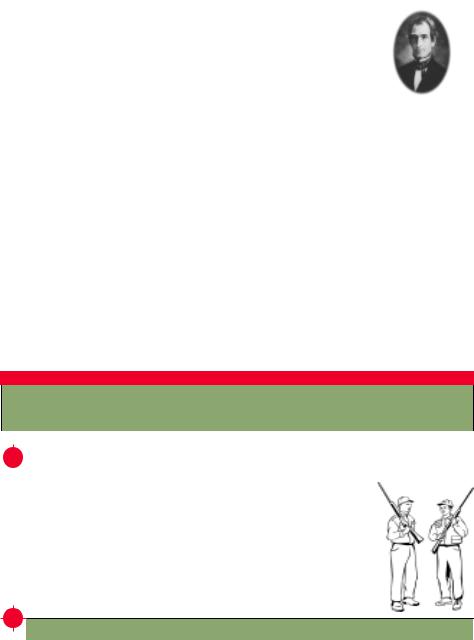
A Tradition of Performance and Safety.
In 1816 Eliphalet Remington was confident he could make a flintlock that was as good or better than any he could buy. His confidence was well founded. The barrel he handcrafted set a new standard for firearm accuracy and spawned generations of products that have made Remington® Arms America's leading gunmaker. While performance and style are certainly hallmarks of Remington firearms, one factor ultimately drives their performance. Safety. Eliphalet Remington never lost sight of the fact that his rifles were potentially lethal and could kill someone if handled improperly. And after more than 190+ years the same holds true for any firearm, including your new Remington. Eliphalet Remington's first flintlock launched a proud tradition of accuracy and responsibility.
Eliphalet Remington’s first flintstock launched a proud tradition of accuracy & responsibility
Safety is Critical to Performance.
A superbly crafted firearm is only as good as the hands that hold it. You can never be too careful. Shooting accidents are often caused by careless oversights such as failing to control the direction of the muzzle,failing to fully engage the safety, leaving ammunition in the chamber or using improper loads. These oversights can result in the destruction of life, limb or property. There's no calling back a bullet once it's been fired, so it's critical that you know the principles of safe firearm handling and storage before you ever take your new Remington firearm out of the box.
The proper use and performance of your firearm depends on correct assembly and maintenance, so it's critical that you familiarize yourself with the information in this instruction book. Even if you're a veteran shooter with a collection of Remington firearms, take the time to read this literature. Not all firearms are the same. That means the first step in safe handling is to learn the features and requirements of your new Remington.
TH E TEN COMMAND MENTS OF FIREARM SA FET Y
The Ten Commandments of Firearm Safety should be etched in your memory forever. Let them govern your action wherever and whenever you’re involved with firearms. In the field. On the range. Or in your home. Please take the time to review and understand these rules.
|
|
|
|
|
|
|
|
|
|
|
||||||
|
|
|
|
1st COMMA |
|
NDMENT |
|
|
|
|
||||||
|
|
|
|
|
|
|
|
|
||||||||
|
|
|
|
ALWAYS KEEP THE MUZZLE POINTED IN A SAFE DIRECTION. |
||||||||||||
|
|
|
|
|||||||||||||
|
|
|
|
|||||||||||||
This |
is the |
most important |
firearm |
safety |
rule. A safe direction |
is one in which |
||||||||||
an accidental |
discharge will not |
cause injury |
to yourself or others. Never |
allow |
||||||||||||
your |
firearm |
to point |
at anything |
you don't intend |
to shoot. Be especially careful |
|||||||||||
when |
you're |
loading |
or unloading. |
Treat |
every firearm as if it were loaded. |
And |
||||||||||
make |
it a habit to know where |
the muzzle |
is pointed at all times, |
even when |
your |
|||||||||||
firearm is |
un-loaded. |
No |
one |
will |
be injured |
by |
an accidental |
discharge if you |
||||||||
keep |
your |
firearm pointed |
in a safe |
direction. |
It's |
as simple as that. |
|
|||||||||
2nd C OMMANDMENT
Firearms should be Unloaded When Not Actually in Use.
Load your firearm only when you're in the field or on the target range and ready to fire. Never let a loaded firearm out of your sight or out of your hands. Unload it as soon as you're finished shooting - before you bring it into your car, camp or home. Remember, unloading your firearm means unloading it completely, so there is no ammunition in the chamber or in the magazine. Before handling a firearm or passing it to someone else, visually check the chamber, receiver and magazine to be certain they do not contain ammunition. Always keep the firearm's action open when not in use. Never assume a firearm is unloaded even if you were the last person to use it. Always check for yourself.
2
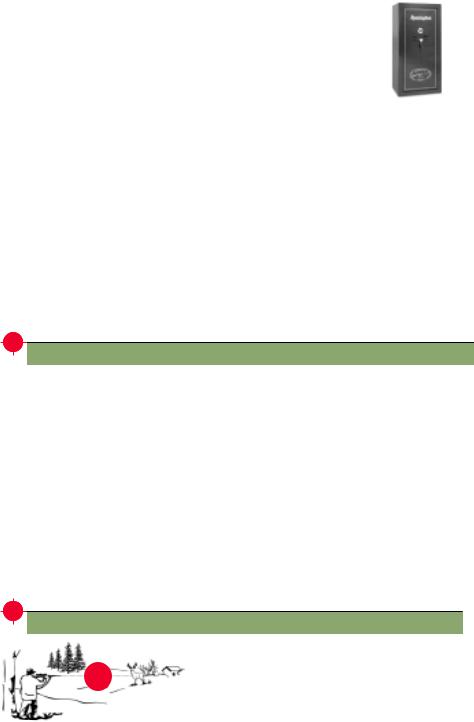
•Let common sense rule when you carry a loaded firearm. If you're in a situation that could risk accidental discharge - such as crossing a fence, wading through a stream or climbing a tree - always unload your firearm. Never pull or push a loaded firearm toward yourself or another person. Never carry a loaded firearm in a scabbard, detached holster or gun case.
•Certain firearms (including some Remington® rifles and shotguns) are equipped
with internal security devices to prevent unauthorized use. In addition, some firearms owners use external devices, such as cable locks and trigger blocks, for the same purpose. Even if you use such a device, you should still keep your firearm unloaded when stored or not in use. And using internal or external devices cannot substitute, however, for securing your firearms and ammunition in a separate, locked location.
Firearms should be stored in a secure place where children cannot access them. A gun safe is an ideal way to secure your firearm
•Safe storage of firearms is just as critical as safe handling. Never store firearms loaded. Be sure to keep your firearms in a secure place where unauthorized persons cannot get their hands on them without your knowledge.
•Take special care if there are children around. Children are fascinated by firearms. It's a natural curiosity that can have tragic consequences when not properly supervised. Store your firearms in a locked gun safe or some other location that physically bars a child from gaining access.
•Ammunition should be stored and locked in a location separate from your firearm. Never leave an unsecured firearm or ammunition in a closet, dresser drawer or under the bed. Remember, it is your responsibility to make sure that children and others unfamiliar with firearms cannot get access to your
firearm and ammunition.
 3rd C OMMA NDMENT
3rd C OMMA NDMENT
DON'T RELY ON YOUR FIREARM'S SAFETY
Treatevery Firearm as if it can fire at any time, whether or not there's pressureon the trigger.Your firearm has been carefullydesignedto maximizeperformanceand safety.However,because a firearm'ssafety is a mechanicaldevice, it could fail.
Human error is a more likely reason for a firearm safety to fail. By mistake,you may think the safety is on when it really isn't. Or the safety may have been disengagedwithout your knowledge.Or you could think your firearm is unloadedwhen there's actuallya cartridgeor shell in it. A mechanicalsafety is not a substitutefor common sense. It's merely a supplementto your proper handlingof a firearm.
Never touch the trigger on a firearm until you are ready to shoot. Keep your fingers away from the trigger when you're loading or unloading. And don't pull the trigger when the safety is engaged or positionedbetween safe and fire.
Before using your firearm, read this instructionbook to understandthe exact locationand operationof your firearm'ssafety.Even when the safety is on, maintaincontrol of your loaded firearm and control the directionof the muzzle. In other words, don't rely on your safety to justify carelesshandling.If your firearm'sinternalmechanisms
are broken or have been altered,your firearm may fire even when the safety is on. Remember,you and your safe |
|
firearm handlingpracticesare your firearm'sbest safety. |
|
4th COMMA |
NDMENT |
BE SURE OF YOUR TARGET AND WHAT’S BEYOND IT.
You can't stop a shot in mid-air, so never fire unless you know exactly where your shot is going and what it will strike. Never fire at a sound, a movement or a patch of color. A nter in camouflage can easily be mistaken for a target by an shooter. Before you pull the trigger be absolutely sure of what's behind it. Make sure the shot has a backstop such as
a hillside or dense material like sand. Remember, bullets can travel great distances with tremendous velocity. Know how far your shot will go if you miss your target or the bullet ricochets.
3

5th COMMA NDMENT
Use Proper Ammunition
Every firearm is designed to use a certaincaliber or gaugeof ammunition. Usingthe wrong ammunition, mixing ammunition or using improperly reloaded ammunitioncan cause serious personal injury or death. And it only takes one cartridge or shotshellof theincorrectcaliberor gauge,or whichhasbeenimproperlyreloaded,to destroy your firearm. It's your responsibility to make sure the ammunition you use exactly matches the caliberor gauge of yourfirearm. Refer to this instructionbook to findoutthespecificrequirements of your firearm.Always read and heed the instructions on ammunitionboxes.
Confusing shells or cartridgescan causeseriouspersonalinjury or deathand destroy your firearm. Examine your shellsor cartridges closely and use only theprecisecaliberor gaugefor your specificfirearm.Forexample,suppose you accidentallyloaded a 20 ga. shell intoa 12 ga. shotgun.Becausethe 20 ga. shell is too smallfor the chamber, the 20 ga. shellcould travel down the barreland get lodgedin the bore.If you then loaded a standard 12 ga. shell behind it and fired, the 12 ga. shot will slam intothe lodged20 ga. shell and may cause the barrel to explode right in your hand. This is commonly called a 12/20burst,and it can kill you.
Check all ammunitionbefore you load it to make sure it matchesyour firearm's requirements.Every Remington® cartridge and shell is head-stamped with its caliberor gaugefor easyidentification.Likewise,you'll find the caliber
or gauge of your new Remington firearmimprintedon the barrel.
Reloading Requires Extra Dil genc .
If you're an ammunitionreloader, you are responsiblefor personallyassuringthat the loads and components of your reloadedammunition meet your firearm'sfactory-testedstandards.Neveruse ammunition, whichhas been reloaded by someone else!
Many shooters handload as a hobby or to save money on commercial, factory-made ammunition. However,it requires a thorough knowledgeof reloading proceduresanda deeprespect for the explosivepotentialof gunpowder.
Firearms are designed, manufactured and proof-tested to standards based on factory-loaded ammunition. Handloaded or reloaded ammunition that deviates, either intentionally or accidentally, from load or component recommendations can be very dangerous.
Reloaders must observe all possiblesafety precautionsand practices relatedto the proper handling of explosives. Whether you're a seasoned reloader or just starting out, you should study the subject, watch reloading demonstrationsand talk to experiencedreloaders.
The first rule of reloading is to always follow the manufacturer'sinstructionsfor the components you're using. They'll tell you to follow certain guidelines. Namely:
1.Don't mix or substitutepowdersor primers.
2.Don't use unknown or substandard components.
3.Use only suitable componentsthat have been factory-testedby reputable ammunition, powder and bullet manufacturers.
4.Always be sure to use the manufacturer'srecommendedrecipewhen reloading.
Notfollowingtheseguidelinescouldresult insevereinjury toyourselforseveredamagetoyourfirearm.Dangerously highpressureandexplosionscanresult fromanoverchargeofpowderorotherdeviationsfrom establishedreloading guidelines.Bevery careful. The processofreloadingexposesyoutoenvironmentallyhazardousmaterial.Lead,which is knowntocausecancerand birthdefects,isthemostcommonsubstancein bullets and shot.Itisimportanttohandle leadbullets andshotwithextreme care. Work onlyin a well-ventilatedareaandalwayswashyourhandsafterexposure and before eating. Neversmokewhile reloading.
Primersand powdersarealso highlytoxic and flammable.So afterreloadingbe sureto cleanup all materials from your work area. Don't leave primer or powder spills anywhere on the floor or bench top. Dispose of all waste material in accordance with the manufacturer'srecommendations.
Finally, when reloading or handloading concentrateon what you're doing at all times. Do not be distractedby talking to others, listening to the radio or watchingTV while reloading.Never reload after consumingalcoholic beverages or drugs of any kind. Youare workingwith extremelyhazardousmaterials and you can't riskevena few seconds of distraction. Remember,if you reload,you are the ammunition manufacturerand you are responsible for the performance and safety of your reloadedammunition.
4
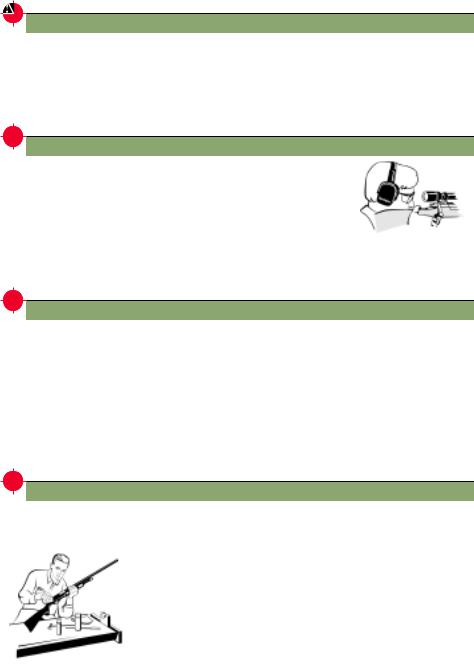
6th CO MMANDMENT
IF YOUR FIREARM FAILS TO FIRE WHEN THE TRIGGER IS PULLED, HANDLE WITH CARE.
If for some reason the ammunition doesn't fire when you pull the trigger, stop and remember the 1st Commandment of Firearm Safety - always keep the muzzle pointed in a safe direction. Keep your face away from the breech, then put the safety on, carefully open the action, unload the firearm and dispose of the cartridge safely. Remember that anytime there's a shell in the chamber, your firearm is loaded and ready
to use. Even if you tried to shoot and your firearm didn't fire, treat your firearm as if it could still discharge.
7th CO MMANDMENT
ALWAYS WEAR EYE AND EAR PROTECTION WHEN SHOOTING.
Your sight and hearing risk injury from shooting and should be protected at all times. Wear protective shooting glasses to guard against falling shot, clay target chips, powder residue, ruptured cartridge cases and even twigs and branches in the field. Also be sure to wear eye protection when you're disassembling or cleaning a firearm so that tensioned parts (like springs) and cleaning solvents don't come in contact with your eyes. Continued exposure to
shooting noise can permanently damage your hearing. On the range, where shooting volume is the loudest, be sure to use the maximum protection of a headset. Learn to use ear protection at all times.
8th CO MMANDMENT
BE SURE THE BARREL IS CLEAR OF OBSTRUCTIONS BEFORE SHOOTING.
Before loading your firearm, open the action and make sure there's no ammunition in the chamber or magazine. Check the barrel for any obstructions or debris. Even a small amount of snow, mud, excess lubricant or grease in the bore can dangerously increase pressure and cause the barrel to bulge or burst when firing. Use a cleaning rod and patch to wipe away anti-rust compounds or any other residues or obstructions in the barrel. Never try to shoot out an obstruction by loading another shell and firing!
When firing, rely on your instincts. If the noise or recoil of your firearm seems weak, stop everything, unload your firearm and be sure nothing is lodged in the barrel. Remember the 12/20 burst? That's what can happen when the barrel is obstructed. Always be sure you're using the correct ammunition in your firearm and that it's free of obstructions.
9th CO MMANDMENT
DON'T ALTER OR MODIFY YOUR FIREARM AND HAVE IT SERVICED REGULARLY.
Your firearm has been designed to operate according to certain factory specifications. You'll jeopardize your safety and that of others around you by attempting to alter its trigger, mechanical safety or other mechanisms. So never alter or modify your firearm in any way.
Like any mechanical device, a firearm is subject to wear. It must be maintained and periodically serviced to assure optimum safety and performance. Only a qualified service facility should service, repair or modify your Remington firearm. Consult your instruction book for instructions on how to send your firearm to the factory or for the location of the nearest Remington authorized repair station.
Proper cleaning and lubrication are also important to firearm maintenance and are necessary to assure accuracy, safety and reliability. Before cleaning, always make sure that your firearm is completely unloaded. And
always clean the barrel from the chamber end to the muzzle when possible.
Make it a practice to clean your bore every time you're going to shoot. Be sure to clean your entire firearm before and after long-term storage and no less than once a year.It's also important to clean your firearm whenever it's been exposed to adverse conditions such as rain, dirt, mud, snow,sleet or saltwater.
5
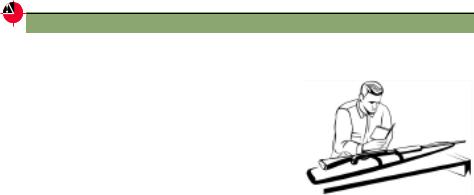
For safe and dependable operation of your firearm, all parts of your firearm must be properly cleaned and lubricated. Periodically inspect the internal workings of your firearm to be sure they're clean and free of rust, unwanted dirt and debris.
Use recommended lubricants on your firearm and do not over-lubricate.Excessive use of a non-recommended lubricant could adversely affect the function and safe operation of your firearm. Remember,you are responsible for the proper care and maintenance of your firearm. Failure to properly maintain your firearm cannot only damage or ruin your firearm, it can expose you and others to unnecessary risks of personal injury or death.
Remington® has a wide range of firearm care products and resources for best results when cleaning your firearm. Everything from solvents and lubricants to rods and patches. They're all available from your Remington
dealer.
10th COMMANDMENT
LEARN THE MECHANICS AND HANDLING CHARACTERISTICS OF YOUR FIREARM.
Not all firearms are alike. They have different mechanical characteristics that dictate how you should carry and handle them. Anyone who plans to use a firearm should first become totally familiar with the type of firearm it is and the safe handling procedures for loading, unloading, carrying, shooting and storing it.
Before you even unpack your new Remington firearm, read this instruction book from cover to cover and familiarize yourself with the different component parts of the firearm. Then read, understand and follow the Ten Commandments of Firearm Safety in this manual.
WARNING! Discharging firearms in poorly ventilated areas, cleaning firearms or handling ammunition may result in exposure to lead, a
substance known to cause birth defects, reproductive harm, cancer and other serious physical injury. Have adequate ventilation at all times. Wash hands thoroughly after exposure.
SHOOT SOBER!!
There's one other rule that must be followed when handling firearms. In fact, respect for this rule is necessary in order to effectively practice the Ten Commandments of Firearm Safety. The rule is: SHOOT SOBER! Firearms and alcohol or drugs make a deadly combination. Never consume anything that would mildly impair your judgment or physical coordination when you're using a firearm. A staggering percentage of the shooting accidents that occur every year involve alcohol or drugs. Be smart. Always shoot sober and stay alive.
WARNING! Failure to follow any of these safety rules may cause personal injury or death to the shooter or bystander and damage to property. Do not use a firearm until you fully understand and practice the Ten Commandments of Firearm Safety. If you have any questions about the safe use of a Remington firearm, write to us at Remington Arms Company, Inc., Consumer Service, P.O. Box 700, Madison, NC 270250700, or call us at 1-800-243-9700.
DON'T KEEP THIS TO YOURSELF.
Now that you're a firearm owner you have the obligation to help ensure that shooting sports are safe for everyone - participants and bystanders alike. You can do that by practicing these principles of firearm safety and passing them on to others - especially new shooters. Set an example for beginners. Be a guide to their safe entry into the exciting world of shooting sports. Invest your time and patience for the love of the sport and for its future. After all, it's your love of the sport that led you to buy a new Remington.
Firearm ownership is a right and privilege. It's a right guaranteed in this nation's Constitution. It's a privilege, which carries with it a personal responsibility to use your firearm in a way which will ensure your safety and the safety of others. The preservation of this right and privilege depends on the personal commitment of you and your fellow shooters to the safe and responsible use of firearms. Let the Ten Commandments of Firearm Safety outlined in the book guide you at all times. Teach and promote these rules whenever you can. Remember, firearm safety depends on you! That's the only way to really enjoy your new Remington firearm and to preserve sport shooting as we know it today.
6
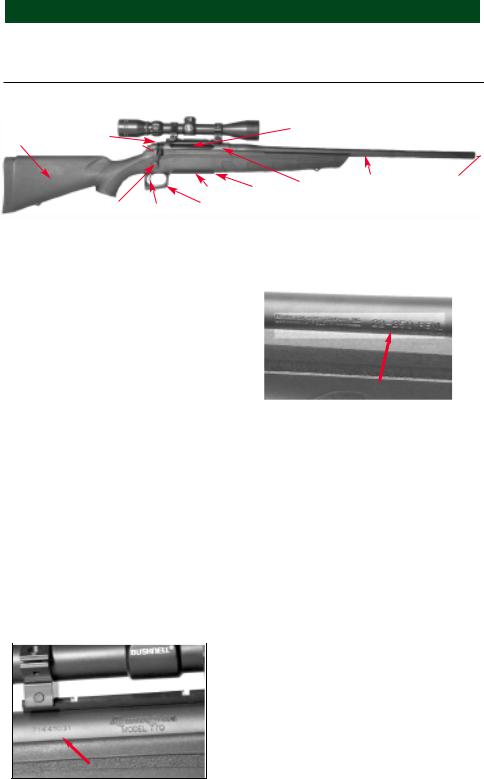
Remington® Model 710™, 715™ 770™ Bolt Action Rifles
Congratulations on your choice of a Remington®. With proper care, it should give you many years of dependable use and enjoyment. For best results, we recommend that you use Remington Ammunition - the ammunition used in factory testing your firearm against our rigorous function and performance standards.
PICTURE 1 This picture shows the main parts of a REMINGTON® Bolt Action Rifle. The picture will aid in understanding the instructions.
|
|
|
|
|
|
|
|
|
|
|
|
|
|
|
|
|
|
|
|
|
|
|
|
|
|
|
|
|
|
|
|
|
|
|
|
|
|
|
|
|
|
|
Bolt Release |
|
|
|
|
|
|
Ejection Port |
|
|
|
|
|
|
|
|
|
||||||||||||||
|
|
|
|
|
|
(Opposite side) |
|
|
|
|
|
|
|
|
|
|
|
|
|
|
|
|
|
|
|
|||||||||||
|
|
Stock |
|
|
|
|
|
|
|
|
|
|
|
|
|
|
|
|
||||||||||||||||||
|
|
|
|
Safety Mechanism |
|
|
|
|
|
|
|
|
|
|
|
|
|
|
|
|
|
|
|
|
|
|
|
|||||||||
|
|
|
|
|
|
|
|
|
|
|
|
|
|
|
|
|
|
|
|
|
|
|
|
|
|
|||||||||||
|
|
|
|
|
|
|
|
|
|
|
|
|
|
|
|
|
|
|
|
|
|
|
|
|
|
|
|
|
|
|
|
|
|
|
|
|
|
|
|
|
|
|
|
|
|
|
|
|
|
|
|
|
|
|
|
|
|
|
|
|
|
|
|
|
|
|
|
|
|
|
Muzzle |
||
|
|
|
|
|
|
|
|
|
|
|
|
|
|
|
|
|
|
|
|
|
|
|
|
|
|
|
|
|
|
|
Barrel |
|
|
|||
|
|
|
|
|
|
|
|
|
|
|
|
|
|
|
|
|
|
|
|
|
|
|
|
|
|
Receiver |
|
|
|
|
|
|
||||
|
|
|
|
|
|
|
|
|
|
|
|
|
|
|
|
|
|
|
|
|
|
|
|
|
|
|
|
|
|
|
|
|
||||
|
|
|
|
|
|
|
|
|
|
|
|
|
|
|
|
|
|
Magazine |
|
Magazine |
|
|
|
|
|
|
|
|||||||||
|
|
|
|
|
|
|
|
|
|
|
|
|
|
|
|
|
|
|
|
|
|
|
|
|
|
|
|
|
|
|
||||||
|
|
|
|
|
|
|
|
|
|
|
|
|
|
|
|
|
|
|
|
|
|
Release |
|
|
|
|
|
|
|
|
|
|
|
|||
|
|
|
|
|
|
|
|
|
|
|
|
|
|
|
|
|
|
|
|
|
|
|
|
|
|
|
|
|||||||||
|
|
|
|
|
|
|
|
|
Bolt Handle |
|
|
|
|
|
Trigger Guard |
|
|
|
|
|
|
|
|
|
|
|
|
|
||||||||
|
|
|
|
|
|
|
|
|
|
Trigger |
|
|
|
|
|
|
|
|
|
|||||||||||||||||
|
|
|
|
|
|
|
|
|
|
|
|
|
|
|
|
|
|
|
|
|
|
|
|
|
|
|
|
|||||||||
|
|
|
|
|
|
|
|
|
|
|
|
|
|
|
|
|
|
|
|
|
|
|
|
|||||||||||||
|
|
|
|
|
|
|
|
|
|
|
|
|
|
|
|
|
|
|
|
|
|
|
|
|
|
|
|
|
|
|
|
|
||||
|
|
|
|
|
|
|
|
|
|
|
|
|
|
|
|
|
|
|
|
|
|
|
|
|
|
|
|
|
|
|
|
|
|
|
|
|
|
|
|
|
|
|
|
|
|
|
|
|
|
|
|
|
|
|
|
|
|
|
|
|
|
|
|
|
|
|
|
|
|
|
|
|
|
|
|
|
|
|
|
|
|
|
|
|
|
|
|
|
|
|
|
|
|
|
|
|
|
|
|
|
|
|
|
|
|
|
|
|
|
|
|
|
|
|
|
|
|
|
|
|
|
|
|
|
|
|
|
|
|
|
|
|
|
|
|
|
|
|
|
|
|
|
|
|
|
|
|
|
General Operation |
Specifications for the correct caliber and |
||||||||||||||||||||||||||||||||||
|
All Remington® centerfire bolt actuated rifles |
cartridge intended for use in your firearm is |
||||||||||||||||||||||||||||||||||
|
operate the same. The firearm is capable of |
located on the shooter’s left side of the barrel. |
||||||||||||||||||||||||||||||||||
|
firing multiple shots after each pull of the |
See Picture 3 |
|
|
|
|
|
|
|
|||||||||||||||||||||||||||
|
trigger and cycle of the bolt. At the start of |
|
|
|
|
|
|
|
|
|
|
|
|
|
|
|
|
|||||||||||||||||||
|
the firing cycle after the trigger has been |
|
|
|
|
|
|
|
|
|
|
|
|
|
|
|
|
|||||||||||||||||||
|
pulled, a cartridge has be discharged, and the |
|
|
|
|
|
|
|
|
|
|
|
|
|
|
|
|
|||||||||||||||||||
|
safety engaged; the action is unlocked and the |
|
|
|
|
|
|
|
|
|
|
|
|
|
|
|
|
|||||||||||||||||||
|
firing pin is cocked by rotating the bolt handle |
|
|
|
|
|
|
|
|
|
|
|
|
|
|
|
|
|||||||||||||||||||
|
upward. As the bolt moves rearward, the |
|
|
|
|
|
|
|
|
|
|
|
|
|
|
|
|
|||||||||||||||||||
|
spent cartridge case is pulled from the |
|
|
|
|
|
|
|
|
|
Caliber |
|
|
|
|
|||||||||||||||||||||
|
chamber. When the spent cartridge clears the |
|
|
|
PICTURE 3 |
|
|
|
Designation |
|
|
|
|
|||||||||||||||||||||||
|
|
|
|
|
|
|
|
|
|
|
|
|
|
|
|
|
||||||||||||||||||||
|
|
|
|
|
|
|
|
|
|
|
|
|
|
|
|
|
||||||||||||||||||||
|
chamber the cartridge is expelled from the |
WARNING! Only use the specified cartridge |
||||||||||||||||||||||||||||||||||
|
firearm through the ejection port. As the bolt |
|||||||||||||||||||||||||||||||||||
|
moves forward a new cartridge is stripped |
type and caliber of ammunition specified for |
||||||||||||||||||||||||||||||||||
|
from the magazine and is placed into the |
your firearm as designated on the barrel. See |
||||||||||||||||||||||||||||||||||
|
chamber. The cycle is completed by rotating |
“To Load Your Firearm”, page 11. |
|
|
|
|||||||||||||||||||||||||||||||
|
|
|
|
|
|
|
|
|
|
|
|
|
|
|
|
|
||||||||||||||||||||
|
the bolt fully downward, locking the bolt and |
The Safety Mechanism |
|
|
|
|||||||||||||||||||||||||||||||
|
cartridge into the firing position. |
|
|
|
||||||||||||||||||||||||||||||||
|
|
|
|
|
|
|
|
|
|
|
|
|
|
|
|
|
|
|
|
|
The manual safety mechanism of your bolt |
|||||||||||||||
|
Important Parts of the |
action firearm provides protection against |
||||||||||||||||||||||||||||||||||
|
accidental or unintentional discharge under |
|||||||||||||||||||||||||||||||||||
|
Firearm |
|
|
|
|
|
|
|
|
|
|
|
|
|
normal usage when properly engaged and in |
|||||||||||||||||||||
|
Serial Number and Cartridge |
good working order. |
|
|
|
|||||||||||||||||||||||||||||||
|
This safety mechanism is not a substitute for |
|||||||||||||||||||||||||||||||||||
|
Designation: |
following the rules of safe firearm handling. |
||||||||||||||||||||||||||||||||||
|
The serial number is located on the shooter’s |
The safety mechanism lifts the sear and |
||||||||||||||||||||||||||||||||||
|
blocks the trigger, preventing the trigger from |
|||||||||||||||||||||||||||||||||||
|
left side of the receiver. See Picture 2. |
|||||||||||||||||||||||||||||||||||
|
being pulled when fully engaged in the “S” or |
|||||||||||||||||||||||||||||||||||
|
|
|
|
|
|
|
|
|
|
|
|
|
|
|
|
|
|
|
|
|
||||||||||||||||
|
|
|
|
|
|
|
|
|
|
|
|
|
|
|
|
|
|
|
|
|
"SAFE" position. |
|
|
|
|
|
|
|
||||||||
|
|
|
|
|
|
|
|
|
|
|
|
|
|
|
|
|
|
|
|
|
The safety mechanism is located on the |
|||||||||||||||
|
|
|
|
|
|
|
|
|
|
|
|
|
|
|
|
|
|
|
|
|
shooters right towards the rear of the receiver. |
|||||||||||||||
|
|
|
|
|
|
|
|
|
|
|
|
|
|
|
|
|
|
|
|
|
To engage the safety mechanism, pull the |
|||||||||||||||
|
|
|
|
|
|
|
|
|
|
|
|
|
|
|
|
|
|
|
|
|
safety lever fully to the rear toward the “S” |
|||||||||||||||
|
|
|
|
|
|
|
|
|
|
|
|
|
|
|
|
|
|
|
|
|
position until the safety arm stops. See |
|||||||||||||||
|
|
|
|
|
|
|
|
|
|
|
|
|
|
|
|
|
|
|
|
|
Picture 4. |
|
|
|
|
|
|
|
||||||||
|
|
|
|
|
|
|
|
|
Serial Number |
|
|
|
|
|
|
|
|
|
|
|
|
|
|
|
|
|
|
|
|
|
||||||
|
|
|
|
PICTURE 2 |
|
|
|
|
|
|
|
|
|
|
|
|
|
|
|
|
|
|
|
|
|
|
|
|
||||||||
|
|
|
|
|
|
|
|
|
|
|
|
|
|
|
|
|
|
|
|
|
|
|
|
|
|
|
|
|
|
|
|
|
|
|
|
|
7

PICTURE 4
Safety Mechanism “Safe”Position
Always engage the safety mechan ism by moving the safet y lever fully rearw ard bef ore handl ing, loading or unlo ading the fire arm.
Whe n you are ready to FIRE the firearm, diseng age the Safety Mechanism by pushin g the safety arm forward to the “FIRE” posit ion, marked with a “F”. You have now disengaged the Saf ety
Mec hanis m and the firearm is ready to FIRE . See Picture 5.
PICTURE 5
Safety Mechanism
“FIRE” Position
Do not touch the trigger while moving the safety mechanism. Your fingers and all other objects should be kept outside of the trigger guard and away from the trigger until you are actually ready to FIRE.
Never attempt to pull the trigger when the Safety Mechanism is activated in the "S” or “SAFE” position.
WARNING! The firearm will fire when the trigger is pulled and the safety mechanism is OFF or in the "F” or “FIRE" position.
Even when the safety is engaged in the "S” or “SAFE" position, careless handling can cause the firearm to discharge. See the
“Ten Commandme nts of Firearm Safety”, on page 2.
WARNING! Do not alter, modify, bypass, or
render the safety features inoperative.
The Locking Device
This firearm was originally sold with a keyoperated locking device or an integrated security system (ISS) to assist the owner in protecting against unauthorized use. These are storage locking devices. The firearm should be completely unloaded when stored or not in use.
These locking devices DO NOT eliminate the need for safe firearm handling and storage, including keeping this and every firearm unloaded and locked in a secure place when not in use. Read and follow these and other safety rules in this instruction manual. Failure to read, understand, and obey these rules can result in serious personal injury or death. See the “Ten Commandments of Firearm Safety”, on page 2.
Keep your locking device engaged when your firearm is not in use. Keep the keys in a secure place, inaccessible to others. DO NOT leave your keys or any ammunition with your firearm, which should be kept unloaded and locked in a safe place.
To secure your firearm with an external locking device, See instructions provided in packaging.
8
